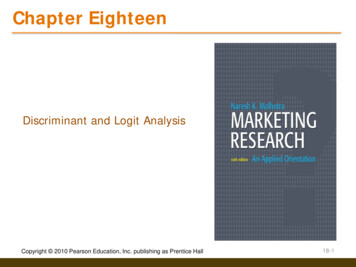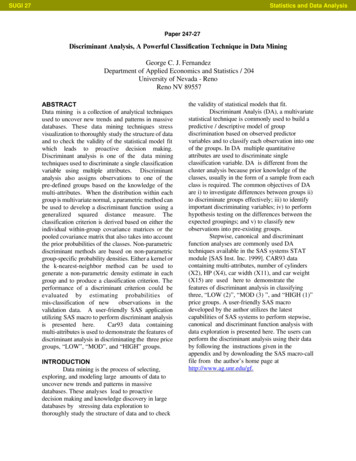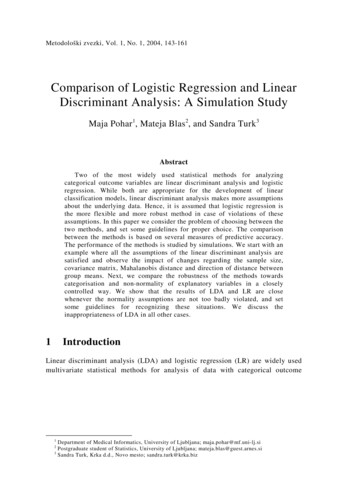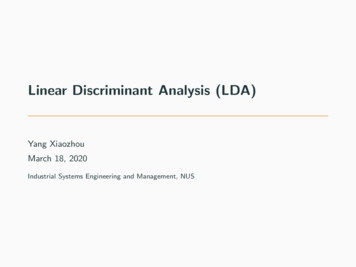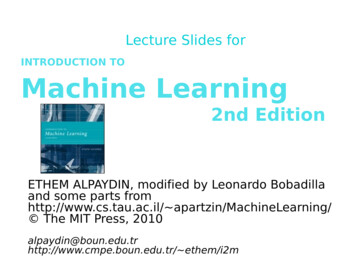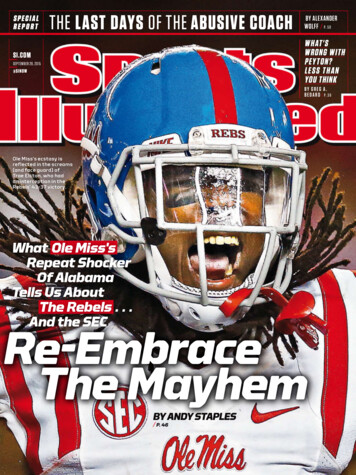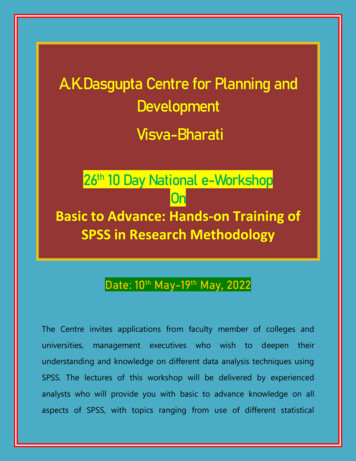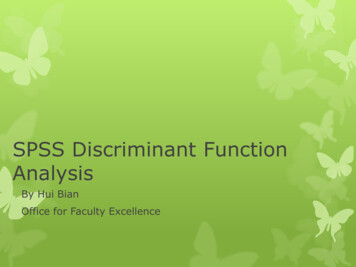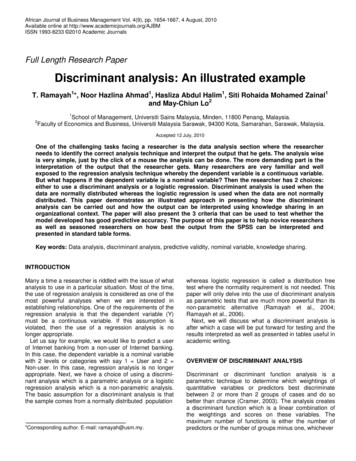
Transcription
African Journal of Business Management Vol. 4(9), pp. 1654-1667, 4 August, 2010Available online at http://www.academicjournals.org/AJBMISSN 1993-8233 2010 Academic JournalsFull Length Research PaperDiscriminant analysis: An illustrated exampleT. Ramayah1*, Noor Hazlina Ahmad1, Hasliza Abdul Halim1, Siti Rohaida Mohamed Zainal1and May-Chiun Lo21School of Management, Universiti Sains Malaysia, Minden, 11800 Penang, Malaysia.Faculty of Economics and Business, Universiti Malaysia Sarawak, 94300 Kota, Samarahan, Sarawak, Malaysia.2Accepted 12 July, 2010One of the challenging tasks facing a researcher is the data analysis section where the researcherneeds to identify the correct analysis technique and interpret the output that he gets. The analysis wiseis very simple, just by the click of a mouse the analysis can be done. The more demanding part is theinterpretation of the output that the researcher gets. Many researchers are very familiar and wellexposed to the regression analysis technique whereby the dependent variable is a continuous variable.But what happens if the dependent variable is a nominal variable? Then the researcher has 2 choices:either to use a discriminant analysis or a logistic regression. Discriminant analysis is used when thedata are normally distributed whereas the logistic regression is used when the data are not normallydistributed. This paper demonstrates an illustrated approach in presenting how the discriminantanalysis can be carried out and how the output can be interpreted using knowledge sharing in anorganizational context. The paper will also present the 3 criteria that can be used to test whether themodel developed has good predictive accuracy. The purpose of this paper is to help novice researchersas well as seasoned researchers on how best the output from the SPSS can be interpreted andpresented in standard table forms.Key words: Data analysis, discriminant analysis, predictive validity, nominal variable, knowledge sharing.INTRODUCTIONMany a time a researcher is riddled with the issue of whatanalysis to use in a particular situation. Most of the time,the use of regression analysis is considered as one of themost powerful analyses when we are interested inestablishing relationships. One of the requirements of theregression analysis is that the dependent variable (Y)must be a continuous variable. If this assumption isviolated, then the use of a regression analysis is nolonger appropriate.Let us say for example, we would like to predict a userof Internet banking from a non-user of Internet banking.In this case, the dependent variable is a nominal variablewith 2 levels or categories with say 1 User and 2 Non-user. In this case, regression analysis is no longerappropriate. Next, we have a choice of using a discriminant analysis which is a parametric analysis or a logisticregression analysis which is a non-parametric analysis.The basic assumption for a discriminant analysis is thatthe sample comes from a normally distributed population*Corresponding author. E-mail: ramayah@usm.my.whereas logistic regression is called a distribution freetest where the normality requirement is not needed. Thispaper will only delve into the use of discriminant analysisas parametric tests that are much more powerful than itsnon-parametric alternative (Ramayah et al., 2004;Ramayah et al., 2006).Next, we will discuss what a discriminant analysis isafter which a case will be put forward for testing and theresults interpreted as well as presented in tables useful inacademic writing.OVERVIEW OF DISCRIMINANT ANALYSISDiscriminant or discriminant function analysis is aparametric technique to determine which weightings ofquantitative variables or predictors best discriminatebetween 2 or more than 2 groups of cases and do sobetter than chance (Cramer, 2003). The analysis createsa discriminant function which is a linear combination ofthe weightings and scores on these variables. Themaximum number of functions is either the number ofpredictors or the number of groups minus one, whichever
Ramayah et al.of these two values is the smaller.Where:Zjk a W 1X1k W 2X2k . W nXnkZCE Optimal cutting score for equal group size.ZA Centroid for Group A.ZB Centroid for Group B.Where:Zjk Discriminant Z score of discriminant function j forobject k.a Intercept.W i Discriminant coefficient for the Independent variablei.Xj Independent variable i for object k.Again, caution must be taken to be clear that sometimesthe focus of the analysis is not to predict but to explainthe relationship, as such, equations are not normallywritten when the measures used are not objectivemeasurements.Cutting scoreIn a 2 group discriminant function, the cutting score willbe used to classify the 2 groups uniquely. The cuttingscore is the score used for constructing the classificationmatrix. Optimal cutting score depends on sizes of groups.If equal, it is halfway between the two groups centroid.The formula is shown below:LowHighCutting score Centroid 1Centroid 2Equal group:Z CS N ZNAB A N ZNBABWhere:ZCS Optimal cutting score between group A and B.NA Number of observations in group A.NB Number of observations in group B.ZA Centroid for Group A.ZB Centroid for Group B.Unequal groupZ CE ZA 2ZB1655THE CASEThe company of interest is a multinational company operating in theBayan Lepas Free Trade Zone area in Penang. The population ofinterest is defined as all employees of this company. Themanagement of the company has been observing a phenomenonwhereby there are some employees who share information at amuch higher level as compared to some others who only share at avery low level.RESEARCH PROBLEMIn a growing organization, knowledge sharing is very importantwhere it will lead to reduced mistakes, allow quick resolution, permitquick problem solving, quicken the learning process andimportantly, all this will lead towards cost saving. Individuals do notshare knowledge without personal benefits. Personal belief canchange individual’s thought of benefit and having self satisfactionwill encourage knowledge sharing. Knowledge sharing does notonly save employer’s and employee’s time (Gibbert and Krause,2002) but doing so in an organizational setting results in the classicpublic good dilemma (Barry and Hardin, 1982; Marwell and Oliver,1983).The management would like to observe the factors thatdiscriminate those who have high intention of sharing from thosewith low intention of information sharing. The reason being, oncethis can be identified, some intervention measures can be put inplace to enhance the information sharing. A review of the literatureunearthed 5 variables that can be identified as possible discriminators-these include attitude towards information sharing, self worthof the employee, the climate of the organization, the subjectivenorm related to information sharing and reciprocal relationship.Following this, the study endeavors to test the effects of the abovementioned factors on knowledge sharing in an organization. Asdepicted in Figure 1, a research model is advanced for furtherinvestigation.Based on the research framework 5 hypotheses were derived asshown below:Ajzen and Fishbein (1980) proposed that intention to engage in abehavior is determined by an individual’s attitude towards thebehavior. In this research, attitude is defined as the degree of one’spositive feelings about sharing one’s knowledge (Bock et al., 2005;Ramayah et al., 2009). This relationship has been confirmed byother researchers in the area of knowledge sharing (Bock et al.,2005; Chow and Chan, 2008). Thus, the first hypothesisconjectured that:H1: Attitude is a good predictor of intention to share information.Reciprocal relationship in this research refers to the degree towhich one believes that one can improve mutual relationships withothers through one’s information sharing (Bock et al., 2005). Themore an employee perceives that his/her sharing of knowledge willbe mutually beneficial, the higher likelihood that the sharing willoccur (Sohail and Daud, 2009; Chatzoglu and Vraimaiki, 2009;Aulavi et al., 2009). As such, it is proposed that:
1656Afr. J. Bus. mIntention to sharelevelSelf worthClimateFigure 1. Research framework.H2: Reciprocal relationship is a good predictor of intention to shareinformation.Subjective norm in this research is defined as the degree to whichone believes that people who bear pressure on one’s actionsexpect one to perform the behavior (Bock et al., 2005; Ramayah etal., 2009). The more the employees perceive that significant otherswould want them to engage in the sharing behavior, the higherwould be their intention to share and vice-versa. This linkage hasbeen proven by several researchers in the knowledge sharingdomain (Bock et al., 2005; Sohail and Daud, 2009; Chen and Hung,2010). Thus, it is predicted that:H3: Subjective norm is a good predictor of intention to shareinformation.Sense of self-worth in this research refers to the degree to whichone’s positive cognition is based on one’s feeling of personalcontribution to the organization through one’s information sharingbehavior (Bock et al., 2005). In a research on knowledge sharing inMalaysian institutions of higher learning, Sadiq and Daud (2009)found that motivation to share significantly predicts knowledgesharing. Other researchers in the knowledge sharing domain havefound the same results (Chow and Chan, 2008; Chatzoglu andVraimaiki, 2009; Aulavi et al., 2009). Based on this argument, it isproposed that:H4: Sense of self-worth is a good predictor of intention to shareinformation.Organizational climate in this research is defined as the extent towhich the climate is perceived to be fair which includes fairness,innovativeness and affiliation (Bock et al., 2005). Severalresearchers in cross cultural research have shown that groupconformity and face saving in a Confucian society can directly affectintention (Tuten and Urban, 1999; Bang et al., 2000; Bock et al.,2005; Sohail and Daud, 2009). Thus, the fifth hypothesis isformulated as follows:The analysisBefore proceeding with the analysis, we have to split the sampleinto 2 portions. One is called the analysis sample which is usuallybigger in proportion as compared to the holdout sample which canbe smaller. There is no standard splitting value but a 65% analysissample and 35% holdout sample is typically used while someresearchers go to the extent of 50: 50. The splitting follows the insample and out sample testing which typically needs another dataset to be collected for prediction purposes. This is achieved bysplitting the sample whereby we develop a function using theanalysis and then use that function to prediction the holdout sampleto gauge the predictive accuracy of the model we have developed(Ramayah et al., 2004; Ramayah et al., 2006). To split the samplewe compute a variable using the function as follows:RANDZ UNIFORM (1) 0.65The value 0.65 means that we are splitting the sample into 65%analysis and 35% the holdout sample. If we would like a 60:40 splitthen we can substitute the value of 0.60 after the function instead of0.65. The procedure for setting up the analysis is presented inAppendix I while the full SPSS output is presented in Appendix II.SUMMARY OF THE RESULTSTables 2, 3, 4 and 5 are summarized from the outputgiven in Appendix II. Values of Tables 2-4 are taken fromthe summary table at the end of Appendix II.To compare the goodness of the model developed, 3benchmarks are used:1. Maximum chanceCMAX Size of the largest groupH5: Climate is a good predictor of intention to share information.2. Proportional chanceVariables, Measurement and Questionnaire DesignCPRO p (1 – p)2To measure the variables of the study, various sources were usedand these are summarized in Table 1, together with informationregarding the layout of the questionnaire.21 – p Proportion of individuals in group 2where: p Proportion of individuals in group 1
Ramayah et al.Table 1. The measures and layout of the questionnaire.SectionABCDEFVariableIdentification numberPersonal dataReciprocal relationship(Recip1 – 5)ItemThe degree to which one believes onecan improve mutual relationships withothers through one’s information sharingSource75Bock et al. (2005)Self worth(Sw1 – 5)The degree to which one’s positivecognition based on one’s feeling ofpersonal contribution to the organization(through one’s information sharingbehavior)5Bock et al. (2005)Attitude towardsSharing (Att1 – 5)The degree of one’s positive feelingsabout sharing one’s information5Bock et al. (2005)Subjective norm(Sn1 – 4)The degree to which one believes thatpeople who bear pressure on one’sactions expect one to perform thebehavior4Bock et al. (2005)Intention to shareThe degree to which one believes thatone will engage in information sharingact1Low/HighClimate(Climate1– 6)The extent to which the climate isperceived to be fair6Bock et al. (2005)Table 2. Hit ratio for cases selected in the analysis.Actual groupLowHighNo. of cases10423Predicted group membershipLowHigh102 (98.1)2 (1.9)16 (69.6)7 (30.4)Percentage of "grouped" cases correctly classified: 85.8%. Numbers in italics indicatethe row percentages.Table 3. Hit ratio for cross validation* (Leave One Out Classification).Actual groupNo. of casesLowHigh10423Predicted group membershipLowHigh102 (98.1)2 (1.9)17 (73.9)6 (26.1)Percentage of "grouped" cases correctly classified: 85.0%. *In cross validation, each case is classified bythe functions derived from all cases other than that case. Numbers in italics indicate the row percentages.3. Press QPress[N - (n * k)]Q N(k - 1)Where:22Q χ with 1 degree of freedom.N Total sample size.n Number of observations correctly classified.1657
Afr. J. Bus. Manage.1658Table 4. Hit ratio for cases in the holdout sample.Actual groupPredicted group membershipLowHigh52 (100)0 (0)6 (46.2)7 (53.8)No. of casesLowHigh5213Percentage of "grouped" cases correctly classified: 90.8%.Table 5. Comparison of goodness of results.MeasureMaximum chanceProportional chanceComparison with Hair et al. (2010) 1.25 times higher than chancePress Q table valuePress Q calculated valueValue0.800.68Hit ratio for holdout sample90.890.80.856.63543.22**** p 0.01.k Number of groups.Press Q Calculation:Q Press[65- (59 * 2)]65(2- 1)2 43.22As shown above, the predictive accuracy of the model forthe analysis sample was 85.8%, the cross validationsample was 85.0% and the holdout sample was 90.8%respectively (see Tables 2, 3 and 4). The values in Table5 indicate that the hit ratio of 90.8% for the holdoutsample exceeded both the maximum and proportionalchance values. The Press Q statistics of 43.22 wassignificant. Hence, the model investigated has goodpredictive power. With a canonical correlation of 0.45, itcan be concluded that 20.3% (square of the canonicalcorrelation) of the variance in the dependent variable wasaccounted for by this model. A summary of the univariateanalysis indicating the influential variables to the low/highintention to share is presented in Table 6.Calculation of the cutting score:ZZ CUCU NAZNBA NNBZFrom the analysis we can see that the 3 significantvariables carry a positive sign which means it helps todiscriminate the employees with high intention to sharewhereas self worth carries a negative sign which helps topredict the low intention to share by employees.Employees who have a more positive attitude andperceive there is a strong reciprocal relationship and subjective norm will have high intention to share. Employeeswho have a lower self worth will have low intention toshare. Table 7 is used to support the arguments givenabove.ConclusionThis paper has presented an illustrated guide to howdiscriminant analysis can be conducted and how theresults can be reported and interpreted in a manner thatis easily understood. The following conclusions can bedrawn based on the analysis: AB104 ( 1 . 063 ) 23 ( 0 . 235 ) 0 . 8236104 23The graphical depiction of the cutting score.0.8034HighCutting score Centroid 1Centroid 2-0.2351.063 Low The higher the reciprocal relationship perceived by theemployees, the higher will be the knowledge shared.The higher the self worth (the degree to which one’spositive cognition based on one’s feeling of personalcontribution to the organization through one’sinformation sharing behavior), the higher will be theknowledge shared.The more positive the attitude towards knowledgesharing, the higher will be the knowledge shared.The higher the degree to which one believes thatpeople who bear pressure on their actions expectthem to share knowledge, the higher will be theknowledge shared.Climate did not play a role in discriminating knowledgesharing levels.
Ramayah et al.1659Table 6. Summary of interpretive measures for discriminant analysis.Independent variableReciprocal relationshipSelf worthOrganizational climateAttitudeSubjective normGroup centroid lowGroup centroid highWilks Lambda2(Canonical nt loading (rank)0.827 (3)0.697 (4)0.059 (5)0.833 (2)0.888 (1)-0.2351.0630.798**0.203Univariate F ratio21.700**15.428**0.11122.007**24.998***p 0.05; **p 0.01.Table 7. Mean comparison of low/high intention to share.VariableReciprocal relationshipSelf worthOrganizational climateAttitudeSubjective normLevel of Intention to ShareLowHighF 3.654.3122.007**3.544.2624.998****p 0.01.The implications that can be drawn form this study is fororganizations to leverage on creating a more positiveattitude among employees which will also result in astronger subjective norm to share knowledge. This inturn, will also have an impact on reciprocal sharing whichwill subsequently enhance the self worth of theemployees. As such, the organizations should strive tocreate a more conducive environment for sharing bycreating more opportunities for employees to work insmall teams and project based assignments rather thanindividual assignments. By creating this kind ofopportunities, the knowledge sharing can be enhancedwhich will eventually lead to better performance for theorganization.REFERENCESAjzen I, Fishbein M (1980). Understanding Attitudes and PredictingSocial Behavior, Prentice Hall: Englewood Cliffs, New Jersey.Aulawi H, Sudirman I, Suryadi K, Govindaraju R (2009). Knowledgesharing behavior, antecedents and their impact on the individualinnovation capability. J. Appl. Sci. Res. 5(12): 2238-2246.Bang H, Ellinger AE, Hadimarcou J, Traichal PA (2000). ConsumerConcern, Knowledge, Belief and Attitude toward Renewable Energy:An Application of the Reasoned Action Theory, Psychol. Market 17(6):449-468Barry B, Hardin R (1982). Rational Man and Irrational Society? SagePublications: Newbury Park, CA.Bock GW, Zmud RW, Kim YG, Lee JN (2005). Behavioral IntentionFormation in Knowledge Sharing: Examining the Roles of ExtrinsicMotivators, Social-Psychological Forces, and Organizational Climate,MIS Q. 29(1): 87-111Chang MK (1998). Predicting unethical behavior: a comparison of thetheory of reasoned action and the theory of planned behavior, J. Bus.Ethics. 17(16): 1825-1834.Chatzoglou PD, Vraimaki E (2009). Knowledge-sharing behaviour ofbank employees in Greece. Bus. Process Manage. J. 15(2): 245-266.Chau PYK, Hu PJH (2001). Information technology acceptance byindividual professionals: a model comparison approach, Decis. Sci.32(4): 699–719.Chen CJ, Hung SW (2010). To give or to receive? Factors influencingmembers’ knowledge sharing and community promotion inprofessional virtual communities. Inf. Manage. 47(4): 226-236.Chow WS, Chan LS (2008). Social network, social trust and sharedgoals in organization knowledge sharing. Inf. Manage. 45(7): 458-465.Gibbert M, Krause H (2002). Practice Exchange in a Best PracticeMarketplace, in Knowledge Management Case Book: Siemens BestPractices, T. H. Davenport and G. J. B. Probst (Eds.), PublicisCorporate Publishing, Erlangen, Germany, pp. 89-105.Hair JF, Black WC, Babin BJ, Anderson RE (2010). Multivariate DataAnalysis: A global perspective, Prentice-Hall: Upper Saddle River,New Jersey.Ling CW, Sandhu MS, Jain KK (2009). Knowledge sharing in anAmerican multinational company based in Malaysia. J. WorkplaceLearning 21(2): 125-142.Marwell G, Oliver P (1993). The Critical Mass in Collective Action: AMicro-social Theory, Cambridge University Press: New York.Ramayah T, Jantan M, Chandramohan K (2004). RetrenchmentStrategy in Human Resource Management: The Case of VoluntarySeparation Scheme (VSS). Asian Acad. Manage. J. 9(2): 35-62.Ramayah T, Md. Taib F, Koay PL (2006). Classifying Users and Non-
1660Afr. J. Bus. Manage.Users of Internet Banking in Northern Malaysia. J. Internet amy.asp.htmRamayah T, Rouibah K, Gopi M, Rangel GJ (2009). A decomposedtheory of reasoned action to explain Intention to use Internet stocktrading among Malaysian investors. Comput. Hum. Behav. 25(2):1222-1230.Sohail MS, Daud S (2009). Knowledge sharing in higher educationinstitutions: Perspectives from Malaysia. VINE: J. Inf. Knowl. Manage.Syst. 39(2): 125-142.Tuten TL, Urban DJ (1999). Specific Responses to Unmet Expectations:The Value of Linking Fishbein’s Theory of Reasoned Action andRusbult’s Investment Model, Int. J. Manage. 16(4): 484-489.
Ramayah et al.APPENDIX ISPSS procedure1661
1662Afr. J. Bus. Manage.
Ramayah et al.1663
1664Afr. J. Bus. Manage.APPENDIX IISPSS OutputDiscriminantAnalysisSampleAnalysis Case Processing SummaryUnweighted CasesValidExcludedMissing or out-of-rangegroup codesAt least one missingdiscriminating variableBoth missing orout-of-range group codesand at least one missingdiscriminating .0656519233.933.9100.0HoldoutSampleGroup iprocalselfworthclimateAttitudeNormValid N 996.74588.66448.68190Tests of Equality of Group 000
Ramayah et al.Analysis 1Box's test of equality of covariance matrices.Log DeterminantsLevelLowHighPooled 69The ranks and natural logarithms of determinantsprinted are those of the group covariance matrices.Test of equality ofvarianceTest ResultsBox's MFApprox.df1df2Sig.50.8013.095156175.171.000Tests null hypothesis of equal population covariance matrices.Measures thestrength ofrelationshipSummary of Canonical Discriminant FunctionsEigenvalues% ofCanonicalFunction Eigenvalue Variance Cumulative % Correlation1.254a100.0100.0.450a. First 1 canonical discriminant functions were used in theanalysis.Wilks' LambdaTest of .000Value that will bereported in Table6Standardized CanonicalDiscriminant Function Function1.263-.051.155.294.635Values that will bereported in Table 61665
1666Afr. J. Bus. Manage.Structure elfworth.697climate.059Pooled within-groups correlations between discriminatingvariables and standardized canonical discriminant functionsVariables ordered by absolute size of correlation withinfunction.Values that will bereported in Table 6Canonical Discriminant Function CoefficientsValues used inwriting a 7.535Unstandardized coefficientsFunctions at Group CentroidsValues used incalculating theCutting Score andreported in Table 6FunctionLevel1Low-.235High1.063Unstandardized canonical discriminantfunctions evaluated at group meansClassification StatisticsClassification Processing SummaryProcessedExcluded192Missing or out-of-rangegroup codesAt least one missingdiscriminating variableUsed in OutputPrior.819.1811.0000192Prior Probabilities for GroupsLevelLowHighTotal0Cases Used in AnalysisUnweighted Weighted104104.0002323.000127127.000
Ramayah et al.Classification Function 4-.686-.0666.9378.255-41.544-53.368Fisher's linear discriminant functionsClassification Results b,c,dCases SelectedOriginalCount%Cross-validated aCount%Cases Not wHighLowHighLowHighPredicted 0100.010423100.0100.05213100.0100.0a. Cross validation is done only for those cases in the analysis. In cross validation, eachcase is classified by the functions derived from all cases other than that case.b. 85.8% of selected original grouped cases correctly classified.c. 90.8% of unselected original grouped cases correctly classified.d. 85.0% of selected cross-validated grouped cases correctly classified.Values reportedin Tables 2, 3and 41667
nant analysis which is a parametric analysis or a logistic regression analysis which is a non-parametric analysis. The basic assumption for a discriminant analysis is that the sample comes from a normally distributed population *Corresponding author. E-mail: ramayah@usm.my. whereas logistic regression is called a distribution free
